
isuredid
-
Posts
506 -
Joined
-
Last visited
Content Type
Profiles
Forums
Events
Posts posted by isuredid
-
-
The coin store on the mid level of Galleria I, right around the corner from See's Candies (another favorite). I used to go there all the time when I was in elementary school and into collecting US coins - you could buy buffalo nickels, mercury dimes, wheatback pennies, indian head pennies, all sorts of out-of-circulation US coins, along with guidebooks and those blue folders to put them in.
That coin store was called Astro City Coins. I remember that place. I thought at the time, that the Galleria was an odd choice for a coin store location, but it seemed to work for a number of years.
A few other stores that I remembered:
Jeans West
Rings by Morrow
Margo's La Mode - I always throught that was a loopy name
Hoffritz Cutlery - I bought a throwing knife there. I may even still have it.
Berry Tree - cards
Christian Science reading room - I always felt sorry for those people in there because I never saw anyone using it.
-
Here is a transcript of an article from the Chronicle of Nov 6, 1966:
State to Honor Century Old School Center
By Louis Hofferbert - Chronicle Reporter
For more than a century--almost since the Allen brothers drove stakes and announced they had established a city--one block in downtown Houston has served as the center of the city's educational system.
It is the block where, as long as 109 years, one month and 21 days, Houstonians gathered to lay the cornerstone of what was to become the Houston Academy.
Through succeeding years and many buildings it was to be known variously as Houston High, Central High, Sam Houston High, and finally the administrative headquarters of the school system.
Under its various names and roots it has witnessed history and made history. Its rolls have carried many of Houston's most illustrious names. Its buildings have been ravaged by time and by fire. Its walls have heard the oratory of Ashbel Smith---and of Lyndon Johnson.
The colorful and significant background of that block 1300 Capitol, will be recognized Tuesday and 1:30 p.m. when a state historical marker will be dedicated in a ceremony of the Harris County Historical Survey Committee.
The Houston Academy was chartered 110 years ago. Mrs. Cornelia Ennis donated the school site and James Stevens, a merchant, willed $5000 for a building. Another $10,000 was raised by popular subscription and construction of the first two-story red brick building began. The cornerstone laying was in September 1857.
The Houston Academy was not a public school. It was maintained by tuition charges and subscription. Its first principal was Dr. Ashbel G. Smith, the pepperpot from Connecticut who did not get here in time to wrest Texas from Mexico, but had a hand in almost everything else undertaken by the new republic.
Dr. Smith (often referred to as Gen. Smith) became Texas first surgeon-general and held the rank of colonel in the 2nd Texas Infantry during the Civil War. He was the first regent of the University of Texas, a founder of the university's medical school, and held such post as ambassador to England and France.
It was from a balcony of the academy that Sam Houston urged Texas in 1860 not to secede from the Union. It was in one of its classrooms that the body of Gen. Albert Sidney Johnston lay in state after his death in the battle of Shiloh. Houston's public school system was established in 1878, but the old academy building was so dilapidated classes were held in the Masonic Hall.
In 1881 the old structure was renovated and named Clopper Institute, in honor of E.N. Clopper, the city's second superintendant of schools.
In 1894 a new Temple of learning was erected. It was an ornate four-story brick building known first as Houston Normal and High school. Later the name was shortened to Houston High, and in 1914 to Central High.
This is the school fondly remembered by most "old-time" Houstonians.
The building was destroyed by fire in March 1919 and was replaced by the first U-shaped section that now occupies the site. The rebuilt school opened in 1921 with 1485 pupils and 70 teachers.
The principal was F. M. Black one of Houston's most beloved school officials, for whom Sam Houston High's famous Black Batallion was named.
The school continued to be known as Central High until 1926 when the name changed to Sam Houston High. It carried that name in the early 1930's when Lyndon B. Johnson taught public speaking and debating there.
Sam Houston High it remained for 26 years. Although there is a Sam Houston High today, it is not the same school. The downtown Sam Houston High was discontinued in 1952 to make way for the school system's administrative offices. In 1955 a new senior high was built on Irvington and was given the Sam Houston name.
Present to take leading parts in the Tuesday ceremony will be Judge Ewing Werlein of the First Court of Civil Appeals, Mrs. Jennie Morrow Decker, granddaughter of Sam Houston; Lester Prokop of the state historical commision, and school Supt. Glenn Fletcher, Harold G. Pyle chairman of the survey commitee will be master of ceremonies, and Frank E. Tritico will introduct the guests.
LBJ with his debate team from his time teaching at Sam Houston High

You can probably guess what is occupying that block today----A parking lot. I am curious about a few things. When they tore down the old Houston Academy building they found a time capsule in the cornerstone full of things from 1857. When they built the 1894 Houston High they put their own time capsule in the cornerstone along with the contents of the 1857 time capsule. What ever happened to those items? And what happened to the historical marker put on that site in 1966?
-
 1
1
-
-
My book also says Central High School burned to the ground in March 1919. Must have been rebuilt. So many buildings burned, was a real problem then.
Looking at the footprint for Sam Houston high school in Sanborn maps. the new school that was built on that site in 1920 was an entirely new structure. They must have just demolished the 1894 building and started over.
Here is one more image of the 1894 Houston High School. It looks like this photo by George Beach was the model for the colorized post card.
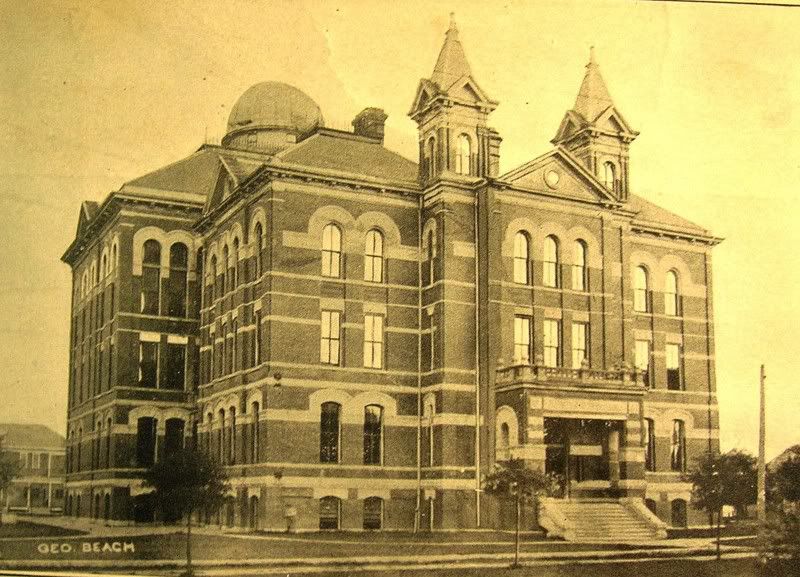
-
 1
1
-
-
I had posted this in the thread on Time Capsules, but it works for this thread too. This is from an 1894 Galveston Daily News article:
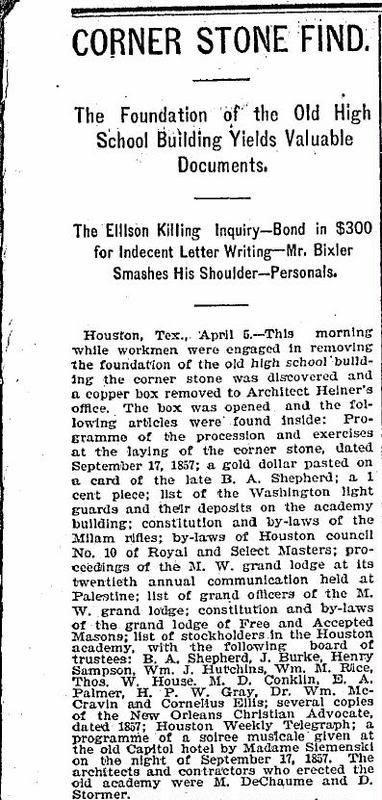
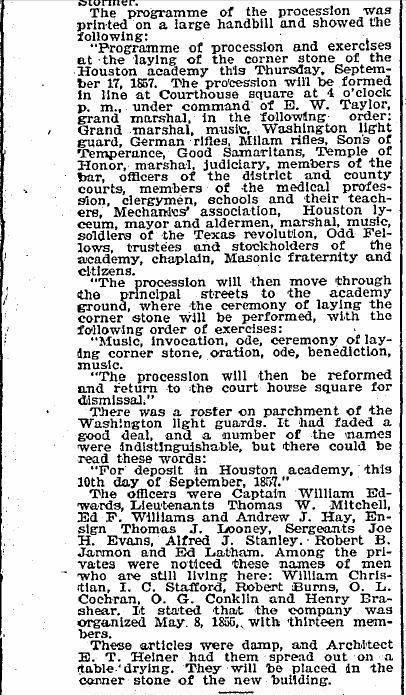
-
 1
1
-
-
Here's another postcard of that school:

-
 1
1
-
-
The Sanborn fire insurance map shows Sam Houston High School replaced that school in 1920 so it didn't last that long
-
 1
1
-
-
Can we find out any more about it? When demolished
 for example.
for example.Appears to be in the high Gothic Victorian Romanesque style, typical in Clayton's designs of the time. I do worship I must admit.
I believe that Eugene T. Heiner was the architect of that school. It was built in 1894 on the site of the previous school which was called the Clopper Institure. They called that block "Academy Square" and was bounded by Rusk, Capitol, Caroline, and Austin streets. I'll see what I can find about when it was demolised.
-
 1
1
-
-
Can someone please identify this high school? Where was it located?
Photo is circa 1907.

Imagine if it had been saved? Even better, can we ever identify the architect? Appears like one of Nicholas J. Clayton's works of art.

Looks like the old Houston High School at Rusk and Caroline
-
 1
1
-
-
Tha was "The Magic Pan". I miss it.
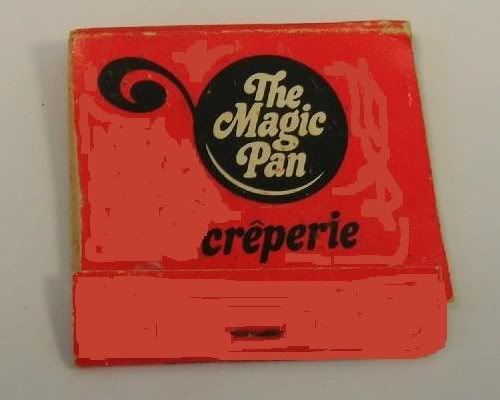
-
Is this the one that you could take a shortcut through from Galleria I to get to Galleria II? It dumped you right over by the theaters ... I could never remember the name of that place.
I believe , gazing through the cobwebs, that the Coquery was where the Chili's is now.
-
I think another interesting pronunciation is for the street Chartres....most people in Houston say Shar-trez or Char-trez, while in New Orleans they call pronounce their Chartres street "Charters". Gruene, Texas is pronounced "Green" , Boerne, Texas is pronounced "Bernie". In Houston Beauchamp is pronounced Beechum. In Austin you might be tempted to pronounce Burnet road Bur-net, but you would be wrong. Local pronunciation is Burn-it. People in Austin may call the river Gua-da-lupay but the street is Gua-da-loop.
-
That other store would be Neiman Marcus, a Texas (Dallas) chain. Oooh La La.
Now I'm getting an itch to leave my swankienda and go shopping at Nieman's
-
I started a search program into the recesses of my brain...the health food store in Galleria I was called Dottie Marlin's Health Food. I also remembered that Nan's Toys used to be in the Galleria, but the rent was too high to make a profit and she moved to SW Frwy. There was a mexican restaurant over by Farrell's called El Felix or El Fenix that I figured was only for tourist because it was not good mexican food. There was also another restaurant called The Coquery. There really weren't that many stores that would be of interest to a teen in Galleria I. I did buy shoes at the Wild Pair and Brass Boot. I had a summer job right after high school working on the dock at Joske's. One of my jobs was to carry bags of merchandise back to the hotels in the Galleria for the, mostly, Mexico City women that would come to Houston to shop at the Galleria. It still trips me out to go into that building that is now Dillard's.
-
I was a rink rat at the Galleria for a period. I bought my first hockey skates (Bauer) at J. Rich Sporting Goods where the food court is now. I remember the small food and drink stand at the end of the rink called the Pacesetter Jr. There was the larger Pacesetter restaurant at the other end of the rink. I used to buy pistachios and other nuts at Morrow's Nut House. There was a health food store down by the Pacesetter restaurant. I can't remember the name of it, but that was the first place I ever bought Dr. Bronner's Magic soap (Teach the moral ABC that unites all mankind, free!)
There was the Sam Houston bookstore, which was a decent bookstore, next to the Hickory Farms and next to that was Disc Records. I knew and hung out with a lot of the people that worked at the record store. The manager of the record was named Skip (can't remember his last name). Skip and most of his crew left that gig to become the first crew of Cactus records when it opened up on Shepherd. Knowing people in the record store business meant that you got into a lot of shows and after-the-concert parties. You also got some of the pickings of the Comp records that the record companies would give to the stores to promote the record. One member of that original Cactus crew, Louis Karp, moved to Austin to open Waterloo Records.
Someone mentioned that they didn't think the Galleria had mall rats, but during the time I was hanging out there, all the regulars of the Galleria knew each other and hung out together. I went on a backpacking trip to Colorado in 1975 with a group of about 10 that was exclusively comprised of Galleria mall rats.
-
We would also frequent the Oakridge Smokehouse for free samples of their beef stick and handfuls of sesame sticks.
I think you are referring to Hickory Farms rather than Oakridge Smokehouse.
-
Sunday, July 30, 1899 - Galveston Daily News
Shepherd's Dam
Houston, Tex, July 29--On the strength of a conversation concerning improvements and advantages in and near the city, a vist was made to D.P. Shepherd's dam, which survived without a scar the recent high water in Buffalo bayou.
It is located in the suburbs of the city, within the allotment of the town of Brunner, to northwest, within three miles from the court house, the axis of the city. In a wonderfully picturesque spot on Buffalo bayou. The dam was built of red cedar curbing, quite finished to eight feet in height and nearly complete to double that altitude. It is owned and was built by Mr. D.P. Shepherd, the father of Texas telegraphers.
Just below the dam is a beautiful spring of almost ice cold water--about a yard square, recently walled in with rock--clear as the azure skies, bubbling up in a dozen places and pouring a beautiful pellucid stream out through a little pipe near its top. The water, while delightful for ordinary uses, has a decided infusion of iron, sulphur, and other things in a desirable character to complete its value in this climate.
The purposes aimed at in the dam are the same as that at Austin and the possibilities are beleived to be quite as great.
-
From 05-15-1892
Names of Streets Changed
By a recent act of the city council the following changes have been made in the names of streets, the names generally being after some one prominently connected with the present or past of Houston:
Wards First and Fourth north: Bradley to Sabine street, Heiss to Colorado street, Stanley street to Stanley place, Park to Johnson street, Nicaragua to Moore, Bismark street to Bismark place, Clay street to Houston avenue, Susan to Kessler street, Cushman street to Cushman place, John to Hickory street, South street to Artesia place, Herbert street to Herbert place, Kane street to Reisner street, Morin street to Morin place.
Second ward: First street, Factory addition, to Lockhart, Second street to Bering street, Third street to Kennedy street, Fourth street to Fox street, Fifth street to Dumble street, Sixth streed to Freund street, Seventh street to Foley street, Clarke street to Flynn street.
Third ward: West Broadway to Hutchins street, East Broadway to Dowling street, Shanghai to Velasco street, Bremond street to Burke place.
Fourth ward south: Bomelt street to Baldwin street, Trinity street to House street, next street west of Trinity to Fuller street, Sabine street to Heiner street, Bayou street to Crosby street, Hobson to Meyer street,Baker to Buckner street, Gentry to Sherman street, Runnels to Cushing street, First street west to Mathews, Second street to Wilson, Third street to Bailey, Fourth street to Gilette, Ennis street to Ruthven, Cline to Cleveland street, First street south to Arnold, Second street south to Cook, Third street Sutton, Center to Erichson street, Houston to Curtin street, Laura street to Rusk avenue.
Fifth ward: Henry and Johnson streets from Webster addition east to Clarke street, to Campbell street, Pascal to Leo street, Campbell to Noble, James street to Sumpter street, Grand avenue and Stephens street to Loraine street, Pinkney to Wills street, Dumble street change to Leona street, Price and John street to Opelousas, Venice and Burr to Liberty street, Second and Bull to Sterrett, First to Grayson street, Ducong and Hare to Nance street, Waverly to Brooks street, Stephens to Hogan, John street Richey addition to Walnut street, Mariana to Huntington, Walker street to Willaimson place.
-
 1
1
-
-
Interesting article, especially the reference to Brunner. First mention I've seen of that community.
Speaking of Brunner, there are some streets there too which need some correcting in the Hinton book, Reinermann street, for one example. Actually all of the north-south streets of Brunner are named after John Reinermann or his heirs and are worthy of a story in a book on Houston street names.
Anton Brunner
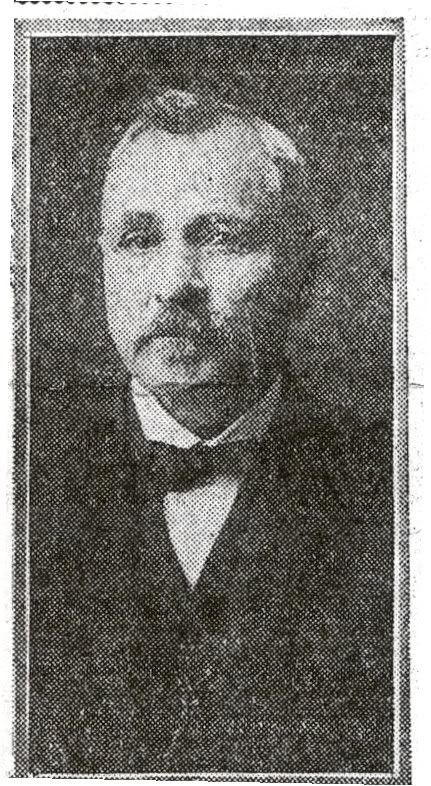
-
 1
1
-
-
Just found a great paper written about street namings, by Marks Hinton, The Heritage Society. link:
http://www.heritagesociety.org/Hinton-Name...ts%20071907.pdf
I've read this before and have the book. I agree with most of Mr. Hiton's explanations for most streets, but have some issues with others. Shepherd Drive is one that bugs me. Maybe this article from the Nov 5th 1922 Galveston Daily News will convince him that Shepherd Drive was not named for B.A. Shepherd:
Houston History Recalled By Opening of New Modern Bridge at "Shepherds Dam"
By Burton Davis
Staff Special to The News
Houston, Tex, Nov 4 - Faith, the Good Book says, can move mountans. Money was what D.P. Shepherd, who built and rebuit Shepherds Dam, did not have enough of; he had plenty of faith. Because Shepherd could not raise enough money there was no water power developed on upper Buffalo River at Houston.
The story of the faith of D.P. Shepherd is brought back out of the dusty files of memory by the opening on Nov. 10, next Friday, of the new and beautiful reinforced concrete bridge over Buffalo River at Shepherds Dam. It was recalled this week too, by the renaming of the road that crosses the bridge, running parallel to the western city limits, about a thousand feet east of the line, and connecting with Washington avenue on the north and San Felipe and Westheimer roads on the south, running into the city.
"Shepherds Dam road" It had been for more than a quarter of a century. At the request of residents of Brunner, now called west end, the city council this week renamed their road "Shepherds Drive" If D. P. Shepherd were alive it would cut him to the quick for it thus offically recognizes on the city maps that the dam on which he spent his savings is out of sight and hereafter will soon be out of mind.
"Shepherd's Folly" they called it for years--that project to develop water power on Buffalo River to turn a grist mill and other possible industries.
Came of Pioneer Family
D.P. Shepherd was a telegraph operator according to old-time Houstonians. He was an uncle of Governor Pat M. Neff and a cousin of B.A. Shepherd, who had become one of the principal owners of the Commercial and Agricultural Bank in 1854, engaged exclusively in the banking business, and was, according to the history cited, the first man in Texas to do so. B.A. Shepherd in 1866 organized the First National Bank with T.M. Bagby, and succeeded to the presidency on the death of Bagby. The First National Bank is still owned mainly by decendants and connections of B.A. Shepherd.
D. P. Shepherd's attempt to build a water mill on Buffalo River was started thirty years ago. It was the first and only such attempt on the stream. The first corn mill in Houston, according to the Standard History, had been built in 1844 by Eltin Stockbridge on the north side of the bayou, not far from the ford then at Texas avenue, where the Interurban car barns stand now. Stockbridge's mill,. which cost the huge sum of $400, used three oxen on a treadmill for power. The "Morning Star" boasted that in a full day's grinding it could grind fifty bushels of corn.
Daniel W. Dickson, known to all of west end as "Uncle Dan" who has lived within sight of Shepherd's Dam on the same spot at 215 Roy street for twenty-nine years, coming on March 1, recalled today for The News the building of the first dam. "Shepherd was building that dam when I came here in March of 1894." said Mr. Dickson. "It was made of cedar logs and brickbats. I had a team of mules and I hauled many a load of "bats" for him from Fred Rice's brickyard in Brunner."
The dam created a ten or twelve foot head of water. Mr. Dickson and F. Cicero Robinson, who has lived in west end for twenty-seven years, agreed, sitting together on the gallery of "Uncle Dan's" house.
"He never did put up his mill." said Mr. Robinson. "He bought a turbine wheel--I reckon it was second-hand; it looked to be, but he never did operate a mill with it. Every few years a freshet in the Bayou would wash out part of the dam and he'd have to spend more money on it. He used up his savings, mortgaged his land and borrowed money until finally he quit.
"The dam backed the water up for nearly three miles. It made a great pleasure resort for Houston and Brunner folks. We had skiffs on it, there was good fishing, and lots of folks came out from town and put on bathing suits in the bathhouse down on the bank."
The last of the dam proper was washed out ten or twelve years ago. Mr. Dickson and Mr. Robinson agreed. Since that time there has been no boating, poor swimming and no fishing, because the oil waste of industries down the stream has spread upward and spoiled both the fishing and swimming. The building of the four-foot dam which is to be part of the new Sabine street bridge, two miles downstream, will back the water up perhaps a foot at Shepherds Dam, will permit the flushing out of the stream during summer stagnation, and will keep the oil off the upper waters and the bayou, or Buffalo River, as it has been rechristened, should again be a pleasure resort for Houstonians.
Mr. Dickson and Mr. Robinson declare that the bayou for miles above Shepherds Dam forms the prettiest woodland scenery within many miles of Houston, and the writer agrees with them. It is their hope that some day before it is too late the city will buy a strip of at least a quarter of a mile wide on each side of the river and for at least two miles above the old dam site. That would cost, at $500 an acre, about $320,000. It would be a wonderful monument to the wealthy man who would buy it now, in its original and untouched beauty and present it to the people of Houston. It is known that a parkway along Buffalo River from the Capitol avenue bridge through Sam Houston Park, the permanent exposition site, past the new Sabine street bridge and on along the meanderings of the stream though Cleveland Park, where another new bridge is just being started, and so up to Shepherds Dam and bridge, is part of the city plan of Houston, to be worked out by the city planning commission which Mayor Holcolmbe is now appointing. If the two miles above Shepherds Dam is not donated to the ciry, as soon as the money can be spared from more pressing needs it is believed that the city will buy the land.
New Bridge Open Friday
The new bridge will be thrown open to traffic next Friday. The next day will be Armistice Day, for which the people of west end are planning a big celebration of the opening of the bridge.
The original bridge was an iron and wooden one, built just above the dam, some twenty-seven years ago. Jules Hirsch, then a county commissioner, got the bridge erected for the people of Brunner.
"It never was much of a bridge" said Mr. Dickson. "But it had to serve us for many years, with repairs two or three times. There were not 100 families in Brunner then. "Brunner was incorporated about that time. It ran from White Oak Bayou on the north to Buffalo Bayou on the south, about a mile and from Patterson street on the east to Reinermann street. A Mr. Lynn was the first mayor and C.D. (Charlie) Green the second. His people still live here. He was a newspaper man on the old Post. The corporation was dissolved after about a year. About ten years ago we voted ourselves into the city of Houston.
The new Shepherds Drive bridge is 168 feet long or 85 feet longer than the old wooden one. It is 37 feet above low water mark, or 10 to 12 feet higher than the old one. It is 43 feet wide, which heavy balustrades of concrete, topped with ornamental lights, and is really a thing on beauty.It was started in May and cost the city $65,000 counting new and higher approaches.
-
It was a book. Roemer's Texas, written in 1845 by a German immigrant named Ferdinand Roemer.
Roemer's book focuses on the experiences of other German immigrants in settling in Texas, and it's still widely read and respected by historians. It's also still available from a number of publishers. You can buy it on Amazon dot com.
You can read the book, Roemer's Texas, online in digital form on the Houston Public Library website.
-
 1
1
-
-
Ooh - nice photo. Hope you don't mind, but I added it to a short blog entry on Japanese rice farmers in Houston. (Say the word, and I'll take it down - I just haven't made it out there to take my own photos yet.)
I do hope that most Houstonians are familiar with the early contributions of Japanese-Americans in this area. I guess they are more obvious in some parts of town than others, though.
No problem using the photo. Here's a photo of the plaque on the front of the building:
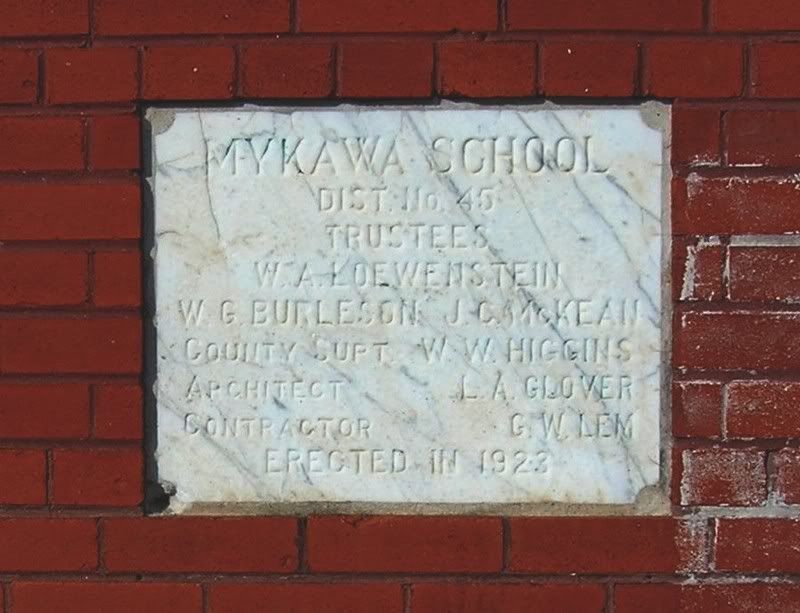
-

Oh, come on. The history of the Mykawa area and the rice farmer Shinpei Mykawa, who introduced rice farming to the area, is well documented.
The Mykawa Road area is poor, no doubt, but Mykawa Road is also a good alternate route to Pearland. I've driven it many times, even at night, and never felt particularly uncomfortable or unsafe. I can think of several areas where I would feel less comfortable at night. Oh, and you can't go east along Mykawa because it runs north and south. As I posted earlier, the old school building is just west of the Mykawa Road intersection on the north side of Almeda-Genoa.
Unless something has changed recently, that building was still abandoned last time I saw it
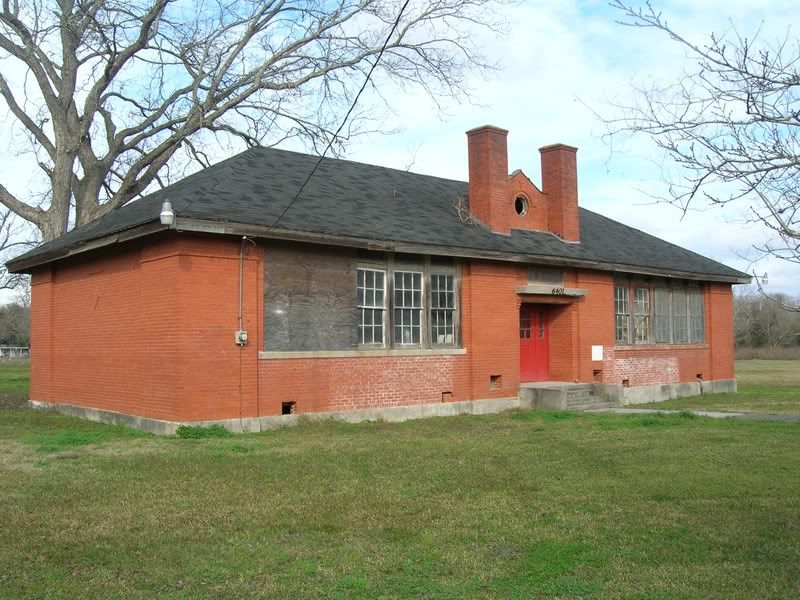
-
Did I read on HAIF somewhere that the Roller Coaster at Luna Park was moved to Playland Park when Luna Park closed down?
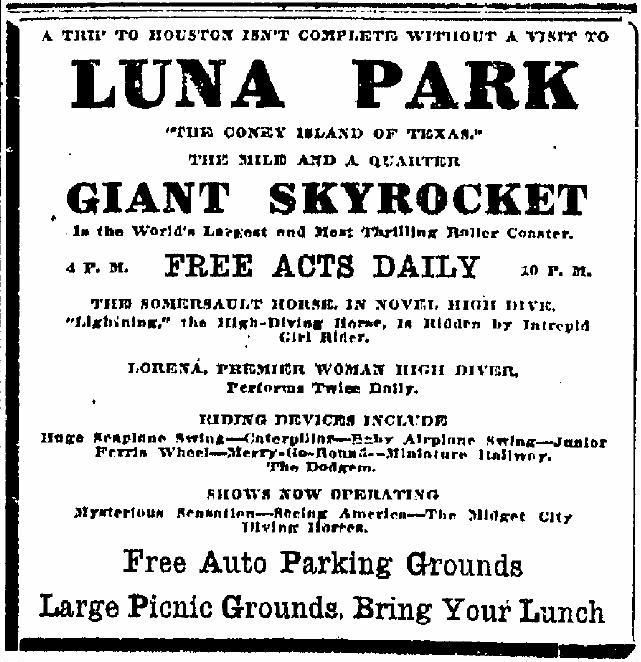
-
At the Texas Room (aka the Houston Metropolitan Research Center) there are also what's called Zingery maps that provide a map of who owned what for specific years, going back to 1956.
.
Bracey's Block Books are also a good place to find names on the property, but it would have to be from before the 1950s to use those. You can also request those books at the front desk of the Texas Room. Once you have a name from the block books, you can trace back through the deed records either forward to now or back to the beginning. Tracing deed records can be a bit complicated if you've never done it, but the folks at Harris County are very helpful.
What is the neighborhood?


The Poor Farms
in Historic Houston
Posted
The original "poor farm" for Houston was across from Glenwood Cemetery.